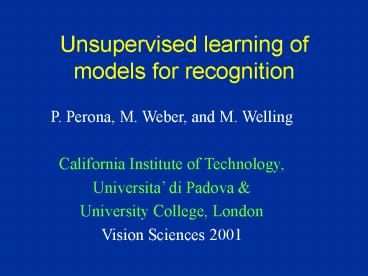Unsupervised learning of models for recognition - PowerPoint PPT Presentation
1 / 43
Title:
Unsupervised learning of models for recognition
Description:
Burl, Leung, Perona 95, 96, 98. Tanaka et al., 1993. Perrett & Oram, 1993. A. Deformations ... [From Burl, Weber & Perona - CVPR 1996] Optimal observer detection ... – PowerPoint PPT presentation
Number of Views:39
Avg rating:3.0/5.0
Title: Unsupervised learning of models for recognition
1
Unsupervised learning ofmodels for recognition
P. Perona, M. Weber, and M. Welling California
Institute of Technology, Universita di Padova
University College, London Vision Sciences 2001
2
Meet the xyz
3
Meet the xyz
4
Meet the xyz
5
Meet the xyz
6
Meet the xyz
7
Meet the xyz
8
Spot the xyz
9
Spot the xyz
10
Spot the xyz
11
Spot the xyz
12
Spot the xyz
13
Spot the xyz
14
Main issues
- Representation
- Recognition
- Learning
ARVO 1999
15
Variability within a category
Intrinsic
Deformation
16
Model constellation of Parts
Tanaka et al., 1993
- Fischler Elschlager, 1973
- Yuille, 91
- Brunelli Poggio, 93
- Lades, v.d. Malsburg et al. 93
- Lanitis, Taylor et al. 95
- Amit Geman, 95, 99
- Burl, Leung, Perona 95, 96, 98
Perrett Oram, 1993
17
Deformations
A
18
Deformations
A
B
19
Deformations
A
B
C
20
Deformations
A
B
C
D
21
Presence / Absence of Features
occlusion
22
Background clutter
23
Generative probabilistic model
Model (Parameters)
Foreground pdf
Prob. of Detection
Background pdf
0.8
0.9
Prob. of N detect.
Pdf of location
pPoisson(N1?1)
pPoisson(N2?2)
0.9
p(x)A-1 (uniform)
pPoisson(N3?3)
e.g. p(x)G(x? ,? )
Example
1. Object Part Positions
3a. N false detect
2. Part Absence
3b. Position f. detect
N1
N2
N3
24
Optimal observer detection
Likelihood ratio test
From Burl, Weber Perona - CVPR 1996
25
Unsupervised learning Frontal Views of Faces
- 200 Images (100 training, 100 testing)
- 30 people, different for training and testing
26
Unsupervised detector training - 1
- Highly textured points are detected with
Förstners interest operator. - can detect corner points and circular patterns
- produces more than 10,000 patterns
27
Unsupervised detector training - 2
Pattern Space (100 dimensions)
28
Parts in model
29
Parameter Estimation
- Obtain training images, suppose we had some
detectors
30
Parameter Estimation
- Signal? Clutter? Correspondence?
optimize for representation (ML on generative
models)
31
ML using EM
1. Current estimate
2. Assign probabilities to constellations (E)
Large P
...
Image i
Image 1
Image 2
Small P
3. Use probabilities as weights to reestimate
parameters (M). Example ?
Large P
x
Small P
x
new estimate of ?
32
Learned face model
Preselected Parts
Test Error 6 (4 Parts)
Parts in Model
Model Foreground pdf
Sample Detection
33
Face images (90 correct classific.)
34
Background images
35
Rear Views of Cars
- 200 Images (100 training, 100 testing)
- Only one image per car
- High-pass filtered
36
Learned Model
Preselected Parts
Test Error 13 (5 Parts)
Parts in Model
Model Foreground pdf
Sample Detection
37
Detections of Cars (87 correct classification)
38
Background Images
39
Dilbert
125 examples
77 examples
vs.
40
Dilbert Model
Model Foreground pdf
Preselected Parts
Parts in Model
Sample Detection
Test Error 15 (4 Parts)
41
Main points
- Probabilistic constellation models (ARVO 99)
- Maximum Likelihood Learning
- Unsupervised learning of object categories in
clutter - Works well on faces, heads, cars, Dilbert,
leaves, handwriting
42
References
- FG 2000 (viewpoint invariance)
- ECCV 2000 (EM algor. for unsupervised learning)
- CVPR 2000 (learning of multiple classes)
- available from www.vision.caltech.edu
- (click on publications)
- Funded by
- National Science Foundation
- Sloan Foundation
Pietro Perona, Markus Weber, Max Welling
43
(No Transcript)































